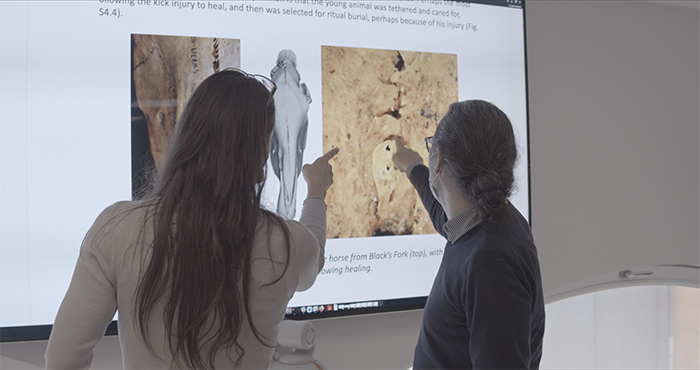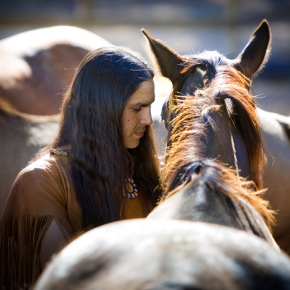
The untold history of the horse in the American Plains, a new future for the world
The continent of North America is where horses first emerged. Millions of years of evolutionary changes transformed the horse before it became the natural companion of many Indigenous Peoples and the flagship symbol of the southwest. An international team uniting 87 scientists across 66 institutions around the world now begins to refine the history of the American horse. This work, which embeds cross-disciplinary and cross-cultural research between western and traditional Indigenous science, is published today in the journal Science.
“Horses have been part of us since long before other cultures came to our lands, and we are a part of them,” states Chief Joe American Horse, a leader of the Oglala Lakota Oyate, traditional knowledge keeper, and co-author of the study. In 2018, at the instruction of her elder knowledge keepers and traditional leaders, Dr. Yvette Running Horse Collin contacted contacted Prof Ludovic Orlando, French National Centre for Scientific Research (CNRS) scientist. She had completed her PhD, which focused on deconstructing the history of horses in the Americas. Up until that point, the field had been dominated by western academics, and Indigenous voices had been largely dismissed. She sought an opportunity to develop a research programme in which traditional Indigenous sciences could be brought forward and considered on equal footing with western science. For the Lakota, scientifically investigating the history of the Horse Nation in the Americas was a perfect starting point, as it would highlight the places of connection and disconnection between Western and Indigenous approaches. The elders were clear: working on the horse would provide a roadmap for learning how to combine the power of all scientific systems, traditional and western alike. And by doing so, eventually provide new solutions to the many challenges affecting people, communities and biodiversity around the globe. For now, as her ancestors before her, Dr. Running Horse Collin would follow the lead of the Horse Nation.
Part of the programme was to test a narrative that features in almost every single textbook on the history of the Americas: whether European historic records accurately captured the story of Indigenous people and horses across the Great Plains and the Rocky Mountains. This narrative reflects the most popular chronicles of the Europeans who first established contact with Indigenous groups and contend a recent adoption of horses following the Pueblo Revolt of 1680.
Archaeological science has emerged as a powerful tool to understand the past, and, if done collaboratively, a strong technique for countering biases built into historical narratives. Over the last decade, Prof. Orlando and his team of geneticists have extracted the ancient DNA molecules still preserved in archeological remains to rewrite the history of the domestic horse. They have sequenced the genomes of several hundred horses that lived on the planet thousands of years ago, up to even 700,000 years ago. This technology could, thus, be reasonably expected to reveal the genetic makeup of horses that lived in the Great Plains and the Rocky Mountains post-European contact.
To tackle this question, Prof. William Taylor, Assistant Professor at the University of Colorado and a large team of partners including archaeologists from the University of New Mexico and University of Oklahoma set out to track down archaeological horse bones from across the American West together with his Lakota, Comanche, Pawnee and Pueblo collaborators. Using both new and established practices from the archaeological sciences, the team identified evidence that horses were raised, fed, cared for, and ridden by Indigenous Peoples. An early date from a horse specimen from Paa’ko Pueblo in New Mexico provides evidence of Indigenous control of horses at the turn of the 17th century, and possibly earlier. Direct radiocarbon dating of discoveries ranging from southern Idaho to southwestern Wyoming and northern Kansas showed that horses were present across much of the Great Plains and Rocky Mountains by the early 17th century, and conclusively before the Pueblo Revolt of 1680. Clearly, the most common narrative for the origin of the American horse needed correction.
The genome evidence demonstrated that the horses surveyed in this study for many Plains Nations were primarily of Iberian ancestry, but not directly related with those horses that inhabited the Americas in the Late Pleistocene more than 12,000 years ago. Likewise, they were not the descendants of Viking horses, despite Viking establishing settlements on the American continent by 1021. Archaeological data show that these domestic horses were no longer in exclusive Spanish control by at least the early 1600s, and were integrated into Indigenous lifeways. Importantly, this earlier dispersal validates many traditional perspectives on the origin of the horse from project partners like the Comanche and Pawnee, who recognize the link between archaeological findings and oral traditions. Comanche Tribal Historian and study coauthor Jimmy Arterberry states: “These findings support and concur with Comanche oral tradition. Archaeological traces of our horse culture are invaluable assets that reveal a chronology in North American history, and are important to the survival of Indigenous cultures. They are our heritage, and merit honor through protection. They are sacred to the Comanche.”
Further work involving new archaeological excavations at sites dating to or even predating the 16th century, and additional sequencing, will help shed new light on other chapters of the human-horse story in the Americas. Pawnee archaeologist and study coauthor Carlton Shield Chief Gover says: “The archaeological science presented in our research further illustrates the necessity for meaningful and genuine collaborative partnerships with Indigenous communities.”
The genome analyses did not just address the development of horsemanship within First Nations during the first stages of the American colonization. These analyses demonstrated that the once dominant ancestry found in the horse genome became increasingly diluted through time, gaining ancestry native from British bloodlines. Therefore, the changing landscape of colonial America was recorded in the horse genome: first mainly from Spanish sources, then primarily from British settlers.
In the future, this team is committed to continue working on the history of the Horse Nation in the Americas to include the scientific methodologies inherent in Indigenous scientific systems, as well as a greater contribution regarding migratory patterns and the effects on the genome due to climate change. This study was critical in helping to bring Western and Indigenous scientists together so that authentic dialogue and exchange may begin.
The challenges that our modern world faces are immense. In these times of massive biodiversity crisis and global climate warming, the future of the planet is threatened. Indigenous Peoples have survived the chaos and destruction brought about by colonization, assimilation policies and genocide, and carry important knowledge and scientific approaches centered around sustainability. It is now, more than ever, time to repair history and create more inclusive conditions for co-designing strategies for a more sustainable future. Importantly, this study created a collaboration between western scientists and many Native Nations across the United States, from the Pueblo to the Pawnee, Wichita, Comanche, and Lakota. We expect to be joined by many more soon. “Our Horse Nation relatives have always brought us together and will continue to do so. Our horse societies are organized and ready. As this collaboration develops, we invite all Peoples of the Horse to join us. We call to you.” (Dr. Antonia Loretta Afraid of Bear-Cook, traditional knowledge keeper for the Oglala Lakota, a study co-author).
This work was supported by the National Science Foundation Collaborative Research Award (#1949305, #1949304, #1949305, and #1949283), Marie Sklodowska Curie Actions (programmes HOPE and MethylRIDE), the CNRS and Université Paul Sabatier (International Research Program AnimalFarm), the French Government “Investissement d’Avenir” France Génomique (ANR-10-INBS-09), and the European Research Council (PEGASUS). All protocols for the transmission of sacred and traditional knowledge were followed, and research activities and results were endorsed by an Internal Review Board involving 10 Lakota Elder Knowledge Keepers, who now serve as the Board of Directors of Taku Škaŋ Škaŋ Wasakliyapi: Global Institute for Traditional Sciences (GIFTS).

© Sacred Way Sanctuary

© Northern Vision Productions
Early dispersal of domestic horses into the Great Plains and Northern Rockies. William Timothy Treal Taylor, Pablo Librado, Mila Hunska Tašunke Icu (Chief Joseph American Horse), Carlton Shield Chief Gover, Jimmy Arterberry, Anpetu Luta Wiŋ (Antonia Loretta Afraid of Bear-Cook), Akil Nujipi (Harold Left Heron),Tanka Omniya (Robert Milo Yellow Hair), Mario Gonzalez (Nantan Hinapan), Bill Means, Sam High Crane (Wapageya Mani), Mažasu (Wendell W. Yellow Bull), Barbara Dull Knife (Mah’piya Keyaké Wiŋ), Wakiŋyala Wiŋ (Anita Afraid of Bear), Cruz Tecumseh Collin (Wanka’tuya Kiya), Chance Ward, Theresa A. Pasqual, Lorelei Chauvey, Laure Tonasso-Calviere, Stéphanie Schiavinato, Andaine Seguin-Orlando, Antoine Fages, Naveed Khan, Clio Der Sarkissian, Xuexue Liu, Stefanie Wagner, Beth Ginondidoy Leonard, Bruce L. Manzano, Nancy O’Malley, Jennifer A. Leonard, Eloisa Bernadez-Sanchez, Eric Barrey, Léa Charliquart, Emilie Robbe, Thibault Denoblet, Kristian Gregersen, Alisa O. Vershinina, Jaco Weinstock, Petra Rajić Šikanjić, Marjan Mashkour, Irina Shingiray, Jean-Marc Aury, Aude Perdereau, Saleh Alquraishi, Ahmed H. Alfarhan, Khaled A. S. Al- Rasheid, Tajana Trbojević Vukičević, Marcel Buric, Eberhard Sauer, Mary Lucas, Joan Brenner-Coltrain, John R. Bozell, Cassidee A. Thornhill, Victoria Monagle, Angela Perri, Cody Newton, W. Eugene Hall, Joshua L. Conver, Petrus Le Roux, Sasha G. Buckser, Caroline Gabe, Juan Bautista Belardi, Christina I. Barrón-Ortiz, Isaac A. Hart, Christina Ryder, Matthew Sponheimer, Beth Shapiro, John Southon, Joss Hibbs, Charlotte Faulkner, Alan Outram, Laura Patterson Rosa, Katelyn Palermo, Marina Solé, Alice William, Wayne McCrory, Gabriella Lindgren, Samantha Brooks, Camille Eché, Cécile Donnadieu, Olivier Bouchez, Patrick Wincker, Gregory Hodgins, Sarah Trabert, Brandi Bethke, Patrick Roberts, Emily Lena Jones, Yvette Running Horse Collin (Tašunke Iyanke Wiŋ), and Ludovic Orlando. Science, March 30 2023.


